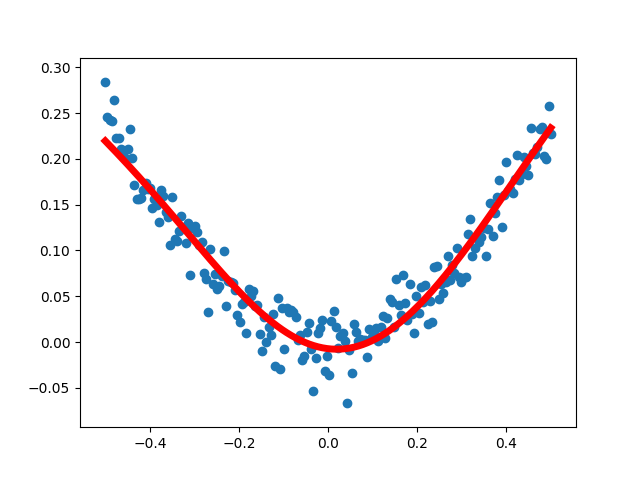代码:
import tensorflow as tf
import numpy as np
import matplotlib.pyplot as plt
#使用numpy来生成两百个随机点, 范围在-0.5到0.5之间,均匀分布
#np.newaxis:插入新的维度
x_data = np.linspace(-0.5, 0.5, 200)[:, np.newaxis]
#生成一些干扰项
noise = np.random.normal(0, 0.2, x_data.shape)
y_data = np.square(x_data) + noise
#定义两个placeholder
#[None, 1]:行数不确定,列数就1列
x = tf.placeholder(tf.float32, [None, 1])
y = tf.placeholder(tf.float32, [None, 1])
#定义神经网络中间层
#输入层1个神经元,中间层10个神经元
Weights_L1 = tf.Variable(tf.random_normal([1, 10]))
biases_L1 = tf.Variable(tf.zeros([1, 10]))
Wx_plus_b_L1 = tf.matmul(x, Weights_L1) + biases_L1
#双曲正切函数作为激活函数
L1 = tf.nn.tanh(Wx_plus_b_L1)
#定义输出层
#中间层10个神经元,输出层1个神经元
Weights_L2 = tf.Variable(tf.random_normal([10, 1]))
biases_L2 = tf.Variable(tf.zeros([1,1]))
Wx_plus_b_L2 = tf.matmul(L1, Weights_L2) + biases_L2
prediction = tf.nn.tanh(Wx_plus_b_L2)
#二次代价函数
loss = tf.reduce_mean(tf.square(y-prediction))
#使用梯度下降法训练
train_step = tf.train.GradientDescentOptimizer(0.1).minimize(loss)
with tf.Session() as sess:
#变量初始化
sess.run(tf.global_variables_initializer())
for _ in range(2001):
sess.run(train_step, feed_dict={x:x_data, y:y_data})
#获得预测值
prediction_value = sess.run(prediction, feed_dict={x:x_data})
#画图
plt.figure()
plt.scatter(x_data, y_data)
plt.plot(x_data, prediction_value, 'r-', lw=5)
plt.show()运行结果:





 本文通过使用TensorFlow和numpy生成随机数据集,并利用神经网络进行拟合,展示了如何解决一个基本的回归问题。文章详细介绍了从数据生成、模型搭建到训练过程的全部步骤。
本文通过使用TensorFlow和numpy生成随机数据集,并利用神经网络进行拟合,展示了如何解决一个基本的回归问题。文章详细介绍了从数据生成、模型搭建到训练过程的全部步骤。

















 被折叠的 条评论
为什么被折叠?
被折叠的 条评论
为什么被折叠?








